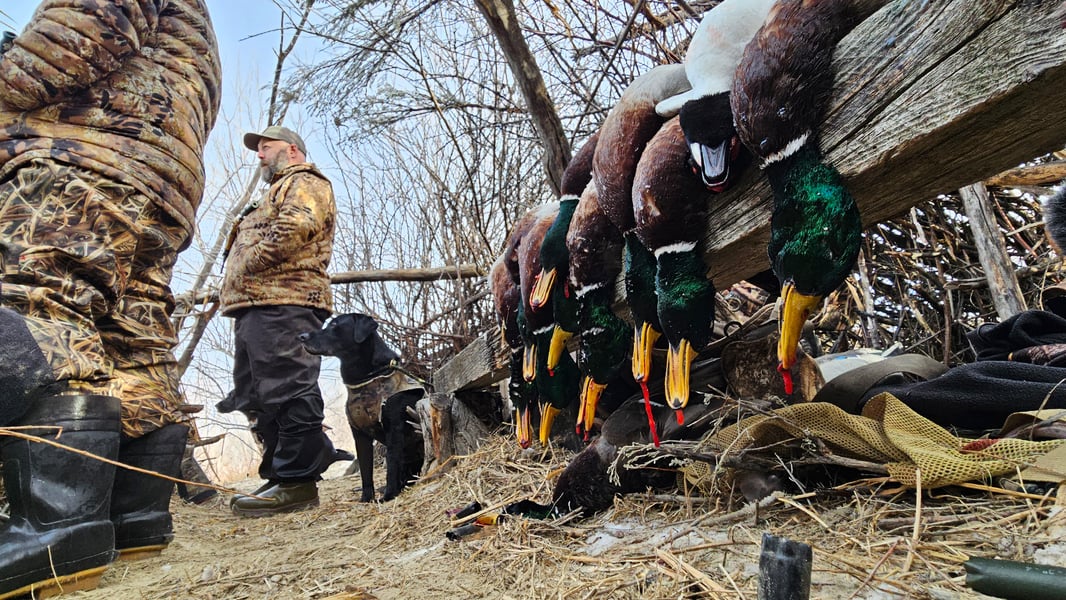Top 5 Waterfowl Skills
By Todd Helms
Get the most from your waterfowl hunts by mastering these five skills
Waterfowl seasons around the country are in full swing but it’s never too late to master skills that will make you a more successful waterfowl hunter. Over my 30+ years of hunting ducks and geese I have narrowed down five skills that make the difference between going home with full straps or empty-handed. Some of these skills may seem obvious but they bear repeating as they can be easy to overlook in the daily grind of waterfowl hunting. I’ve listed them in order of importance as I’ve learned the hard way what the steps to success are when chasing ducks and geese across a variety of environments. I also dive into even more detail on the Eastmans’ Wingmen Podcast so be sure to check out that episode and leave me whatever questions you have in the comments.
Scouting
You can’t kill what you can’t find. . . this one seems simple but it’s ranked number one for a reason. If you give me two days to hunt I’m going to spend the first one scouting. Fields, water, ducks or geese, it doesn’t matter. I want the absolute best intel I can gather so my hunt is as close to perfect as possible.
Scouting is about more than just finding birds too. Once I’ve located birds and secured permission I want to observe exactly what the birds are doing and how they are using the location. Are they roosting? Maybe it’s a loafing spot. If it’s a feed where do I need to set up and how do my decoys need to be arranged to mimic the exact behavior the birds are doing.
Using onX Hunt to e-scout is a great starting point and breaking out my Leupold optics to get a close look at what the birds are doing without disturbing them is another key component to my scouting success. That said, I’m never satisfied with just finding birds. I want to watch them and take notes on exactly what they are doing so I can mimic it with my decoy setup and figure out the best hide I can so they have zero inkling of what awaits when they slide into the spread.
Shooting
I rank shooting as the second most important skill because you can decoy all the birds you want but if you can’t hit them all your scouting is for naught. Shooting is a perishable skill and can be easily overlooked in the fast-paced lives most of us lead. The good news is that it’s fun to practice. If you’re like me you’ve let this waterfowl season sneak up on you and your shooting is suffering a bit. STOP! Take some time and go shoot some trap, skeet or sporting clays between now and your next hunt. It will pay dividends. Get some Federal Top Gun target loads and get after it, knock that rust off before you get in the blind and your success will skyrocket.
HIde/Blinds
Last weekend was the first bigtime duck hunt for my crew. At first light we were covered in birds and all was well. However, as the morning wore on we were having trouble finishing birds in the decoys. They weren’t flaring but they weren’t decoying either. They were seeing us!
We hit the pause button and took thirty minutes to add more brush and grass to our hide. . . it made all the difference. The next birds sucked right into the spread and we tripled on fat drake mallards.
A poor hide doesn’t always result in birds flaring, that’s obvious and easy to recognize. Birds that begin to work and slide off or don’t finish are a more subtle sign that your hide isn’t dialed. Stop the hunt and fix it!
This doesn’t matter if you’re hunting dry-field honkers or ducks in a marsh. If your hide isn’t perfect you won’t kill as many birds as you would otherwise. It’s easy to get lazy on this and I rank this skill number three on this list but it could easily be number two.
Decoys
My first step in hunting preparation each year is to powerwash my decoys to make sure they “pop” in the field. Dirty, drab or dull decoys don’t look like real birds and the results will speak for themselves. Clean ‘em up and touch up the paint if necessary, you’ll thank me later.
Having all the clean decoys in the world won’t matter if they aren’t set correctly though. When you’re scouting you need to pay attention to how the birds are relating to the location and set your decoys accordingly. Are the geese lined out feeding like cattle at a trough? Set your dekes the same way. Ducks loafing on gravel or sand bars? Break out the full bodies and mimic what you have watched the live birds do. Too many folks simply toss out their decoys in a hurry and don’t pay attention to the details. Stop doing that and start mimicking the birds. You will decoy and kill more ducks and geese when you start paying attention to how they are actually behaving.
Motion decoys are cool but it’s more important to have the correct motion in your spread than just motion in general. For dry-land ducks having several spinners in your decoys is a must. On the water. . . I’ve started to opt for jerkstrings, rippling or pulsating decoys or those “fountain” butts to create realistic, water-based movement. Live ducks move and create ripples and splashes on the water, your decoys need to do the same. If you want to run a spinner over water, use several if possible and sink them to the waterline. They look more realistic this way and help you stand out from the single-spinner crowd.
Motion for geese? I still like a flag better than anything else. I rarely flag geese to the ground anymore. Instead I flag them on the corners to keep them interested while not waiving it right in their faces. Flappers work but are bulky and tedious to set up compared to the simplicity of flags. Plus sticking a flag in the hands of folks who can’t call is a great way to make them more than just a trigger puller on a hunt.
Calling
Good calling is sexy, it’s fun and it’s a large part of what makes waterfowl hunting so addicting. Bad calling isn’t just hard on the ears, it spooks birds. Knowing when not to call is as important as knowing how to call properly. If you’re not a good caller it’s okay, scouting, hide and proper decoy placement will kill more birds every single time than competition-grade calling.
Over the years I’ve simplified my calling techniques and it has helped me kill birds more consistently than blowing my lungs out at every bird that swings past. For ducks, simple quacks and chuckles work better than the classic five-note Quaaaaack, Quaaaack, Quaaack, Quaack, Quack. I still hail call and comeback call to ducks but I pay close attention to their body language as oftentimes, especially when ducks are pressured, you can turn them off very easily by hitting them with a harsh call. Another note, when the ducks are doing what I want them to do, I do not call at all.
The same is true for honkers; less is usually more. Get their attention, tone it down and coax them into the decoys with soft murmurs and honks. When they swing, give them some excited double-clucks to make them turn and then throttle it back when they respond. For little geese it’s different, you have to usually lean on them with a ton of noise to keep them excited and doing what you want, more noise is usually better for littles.
There you have it, my Top 5 Rules for Waterfowling Success. The podcast I recorded on this topic goes into tons of detail about each of these skillsets and I would encourage you to give it a listen wherever you get your podcasts. As always, get out there and hunt, enjoy each moment and pass it on when you can.
Eastmans’ is a three generation media based hunting company whose goal is to promote the pursuit of elk hunting, deer hunting and all western big game.
Links
Support
Join our FREE newsletter for up-to-date hunting information
307-754-5584 | POWELL, WY | Email Us
Eastmans’ is a three generation media based hunting company whose goal is to promote the pursuit of elk hunting, deer hunting and all western big game.
Links
Support








